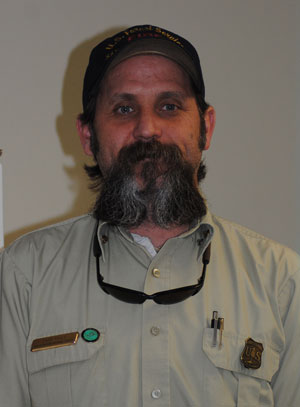
Photo by JP Crumrine
Battalion Chief Chris Fogle of the San Jacinto Ranger District has assumed command of one of the three Type 2 Incident Management Teams in Southern California.
Fogle, entering his 25th fire season, all on this district, succeeds former District Fire Manager Norm Walker as the incident commander of the SoCal Team 1. For the past two years, Fogle has been a trainee for an IC position.
“I’ve worked for Norm on that team for more than 10 years,” Fogle said. “Norm did a great job leading this team. Incredible.”
Their history of partnership, not only managing Team 1, but on the district, will not end with Fogle’s promotion. Walker has agreed and Fogle is delighted and grateful that Walker will be the deputy IC for the next two years.
Becoming an IC requires talent, intelligence and experience. Teams are sent to major fire sites and assume command from the local units. The teams are essentially management units. They oversee and organize services such as planning, logistics, finance and more.
Their members develop plans for fighting these large conflagrations and organize the resources to accomplish the task. The assignments normally are for two weeks. If the fire is not controlled, they can be extended or another IMT can be assigned.
For example, in 2013, within a day of the Mountain Fire starting, a Type 1 IMT was brought onto the district. While the Hill was evacuated, the team had to secure, house, feed and deploy more than 3,000 firefighters within days.
Fogle’s most recent IMT role has been the operations chief for his team. During his years with the unit, the team has been sent to states throughout the country, including Arizona, Utah, Oregon and Alaska.
Besides Fogle, the district has more than a half-dozen firefighting managers involved in various IMTs. This includes Fire Management Officer Fred Espinoza, a member of California’s Type 1 Team 5.
“It’s a good thing [Chris] is going to do that,” Espinoza said. “We have a lot of participation in IMTs.”
One benefit Espinoza described was the experience of working with other local units. Often ideas and practices can be brought back home and implemented, thus improving efficiency here, too.
Other members of this district who participate in one of the Southern California IMTs are Battalion Chief Matt Boss, captains Jim Snow, Daniel Diaz and Jim Escandell, Engineer David Swan and Doug Ross from the Keenwild Helibase. Also, two former San Jacinto fire management officers, Walker and Dan Felix, who retired in April, are still active with their IMT.
All members of an IMT must meet the latest qualifications from the National Wildfire Coordinating Group, the U.S. Forest Service, the California Incident Command Certifications System and Cal Fire. Forest Service employees must get approval through their forest supervisor.
IMTs are multi-agency units composed of members from the Forest Service, the Bureau of Land Management, the National Park Service, the Bureau of Indian Affairs, U.S. Fish and Wildlife Service, and state and local government fire departments.
Their fire assignments are usually two weeks, according to Fogle, but can be extended for a week or more.










